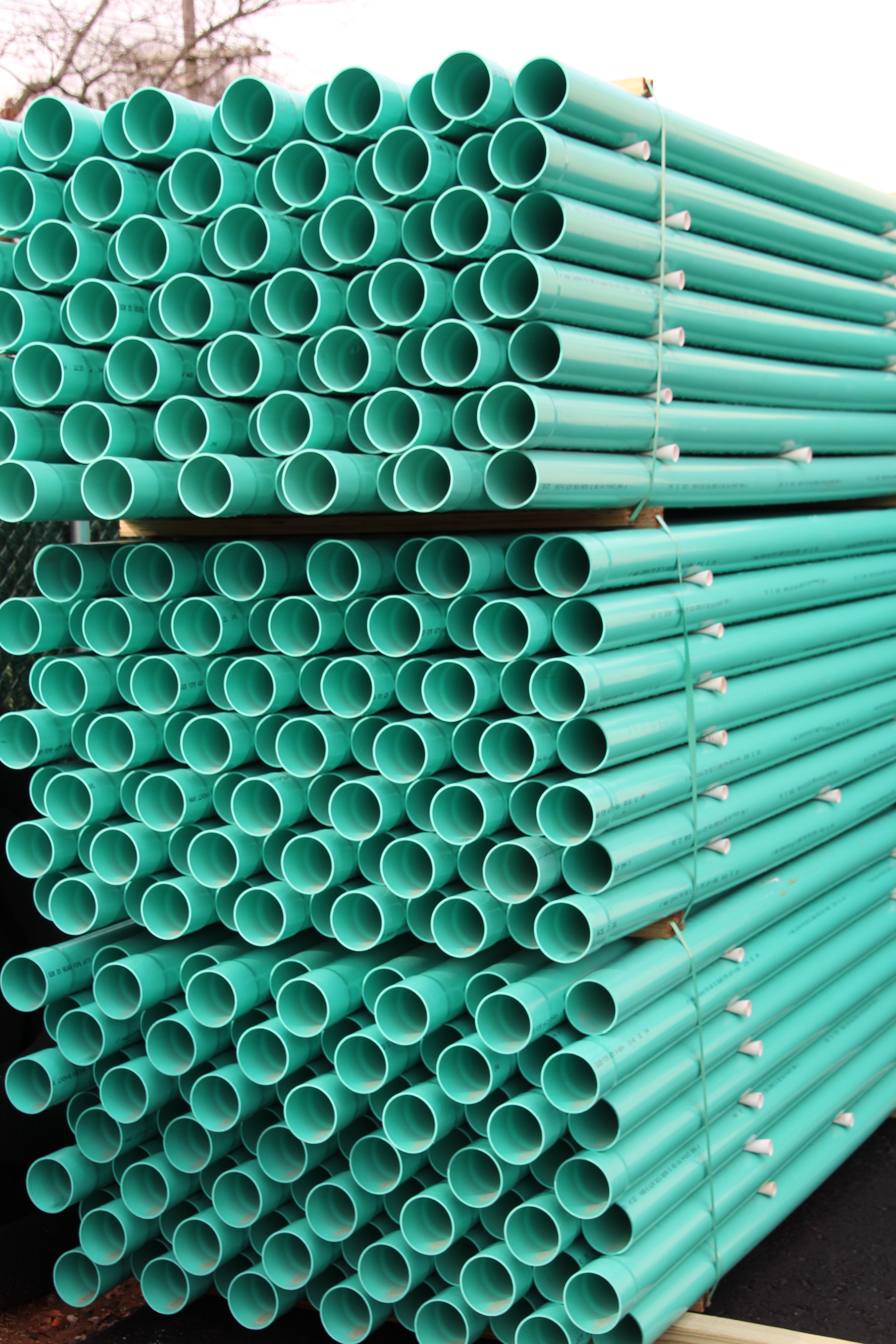
PVC Sewer Pipe Specifications
SPECIFICATIONS FOR PLASTIC GRAVITY SEWER PIPE
TYPE OF PIPE
This specification covers polyvinyl chloride (PVC) gravity sewer pipe and fittings manufactured in accordance with ASTM Standard D-3034 and intended for use in drainage of sanitary and industrial wastes, storm water, and similar liquids. The pipe shall be made by continuous extrusion of green unplasticized PVC plastic and marked HAWK, as well as other markings prescribed by the ASTM Standard.
CHEMICAL RESISTANCE
The resistance of the pipe and fittings to chemical reagents shall be tested in accordance with ASTM D-543 “Test for Resistance of Plastics to Chemical Reagents) and changes, if any, in weight or tensile strength must not exceed the limits specified in Table 2, ASTMD-1784.
FITTINGS
All fittings shall be of the same material as the pipe and shall be consistent therewith in strength, dimensions and utility. Adapters shall be provided for transitions to other pipe products.
DIMENSIONS
Dimensions of pipe and fittings up to 15” in diameter shall conform to ASTM D-3034 for “Type PSM Polyvinyl Chloride (PVC) Sewer Pipe and Fittings”. Nominal laying lengths shall be 14 feet. Other lengths are available on special order.
JOINTS
Pipe Joints are to be made either by the use of solvent cement or an integral bell with elastomeric gasket.
MATERIAL
Both pipe and fittings shall be made of PVC plastic having a cell classification of 12454-B as prescribed in ASTM D-1784. It shall be highly resistant to hydrogen sulfide, sulfuric acid, gasoline, oil, and other chemicals commonly found in sewage and industrial waste. It shall have a smooth internal surface for minimum flow resistance. When properly bedded and back-filled it shall withstand normally encountered loads without rupturing or leaking at the joints. In normal atmospheres, the pipe shall have a self-extinguishing flammability characteristic.
FOR CEMENTED JOINTS
The solvent cement used in cemented joints shall meet the requirements of ASTM D-2564 “Standard Specification For Cement For Polyvinyl Chloride (PVC) Plastic Pipe And Fittings.” It shall produce a watertight joint that will have sufficient strength within five minutes after assembly to permit normal installation, handling and moving.
FOR GASKETED JOINTS
Gasketed joints shall be used where service conditions may subject the installation to expansion, contraction, angular displacement of deformation of the pipe. To facilitate the assembly of gasketed joints, each pipe bell end shall have an internal groove to hold the gasket in place while inserting the spigot end of a mating pipe or fitting. Spigot ends shall have a chamfer and smooth external surface so that they may be readily mated with bell ends without cutting or deforming (pinching) the gasket.
The pipe joint meets ASTM D-3212 for joints for drain and sewer pipes using flexible elastomeric seals, and the seals meet ASTM F-477 for elastomeric seals. All gaskets are factory installed and have a steel reinforcing ring (Locked-in).
INSTALLATION SPECIFICATIONS
The pipe shall be installed in accordance with recommended practice ASTM D-2321.
Joining with Solvent Cement shall be performed in accordance with ASTM D-2855 “Making Solvent
Cemented Joints with PVC Pipe and Fittings” so that mating surfaces are tightly fused.Gasket joints are to be assembled as follows:
With a dry rag, clean the mating surfaces of both the bell and spigot ends to be jointed.
Make sure the gasket grove is clean.Cover the beveled lip of the spigot with lubricant.
Push the spigot end into the bell until you feel the resistance of the gasket.
With pipe sections in straight alignment push the spigot into the bell by applying force to the far (bell) end of the pipe length or fitting being added to the line. If a pry bar is used to apply force, the pipe and bell should be protected by a short two-by-six board placed across the pipe end. If normal force is not sufficient to complete the joint, disassemble the joint and examine the parts to make sure they are free of obstructions. AT NO TIME should a back-hoe or similar device be used to assemble pipe.
TESTING
After backfilling, the pipeline may be tested for leakage. The leakage from any section of PVC Sewer, manhole to manhole, shall not exceed 50 gallons per inch diameter per mile per day.
EXTERNAL EARTH LOAD
The prime consideration when designing a flexible conduit line is the degree of deflection possible under various conditions. The bedding conditions surrounding the flexible conduit rather than the wall thickness of the pipe is the single most important factor affecting the degree of deflection of the line.
PVC sewer pipe should be designed for not more than 7.5% deflection. The engineer should specify Class 1, 2 or 3, as found in ASTM D-2321 bedding depending upon the soil conditions and the depth of the cover.
INSTALLATION AND HANDLING EASE
Lightweight (approximately one-sixth the weight of steel and one-half the weight of aluminum.) Smooth
Seamless walls require no specialty cutting tools. A “Reiber Seal” provides easy installation by simply pushing the “Reiber Seal” gasketed pipe together with a plain spigot. PVC Sewer Pipe should be installed in accordance with ASTM D-2321 “ Practice for Underground Installation of Flexible Thermoplastic Sewer Pipe.”
CHEMICAL/CORROSIVE RESISTANCE
HAWK PLASTICS, LLC Rigid PVC pipe has inert qualities which resist internal chemical attack by most acids, alkalics, salts, and organic media such as alcohols and aliphatic hydrocarbons when applied within specified temperature and pressure limits. It cannot react with materials carried, nor act as a catalyst. This eliminates the disadvantages of special metals, lined piping, glass, wood, ceramics, or other special corrosion resisting materials. The possibilities of contamination through chemical process, clouding, sludging or discoloration are also negated.
Externally, there is no possibility that industrial fumes, humidity, salt water, weather (atmospheric or underground) conditions (regardless of soil or moisture content) can lower its protective quality. Scratches or surface abrasions are unaffected by corrosion attack.
GALVANIC OR ELECTROLYTIC ACTION
HAWK PLASTICS, LLC PVC Pipe is inherently immune to galvanic or electrolytic action and can be applied underground, underwater, in the presence of metals, in connection with, or as an insulator for other materials.
